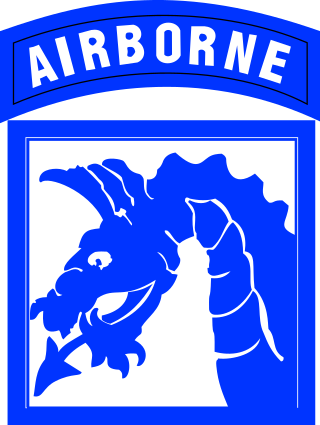
The XVIII Airborne Corps is a corps of the United States Army that has been in existence since 1942 and saw extensive service during World War II. The corps is designed for rapid deployment anywhere in the world and is referred to as "America's Contingency Corps." Its headquarters are at Fort Bragg, North Carolina.

The 20th Engineer Brigade is a combat engineer brigade assigned to the XVIII Airborne Corps of the United States Army stationed at Fort Bragg, North Carolina. Although the brigade was identified as an airborne unit, not all of its subordinate units were airborne qualified—despite the airborne tab as part of the unit patch. Soldiers of the 20th Engineer Brigade provide various supportive duties to other Army units, including construction, engineering, and mechanical work on other Army projects.

Carl Ames Strock was a United States Army officer, and was Chief of Engineers and the Commanding General of the United States Army Corps of Engineers. He was born in Georgia and grew up in an Army family. He enlisted in the Army and received his commission as an infantry second lieutenant following graduation from Officer Candidate School in 1972. After completing Ranger and Special Forces training, he served primarily with infantry units before transferring to the Engineer Branch of the U.S. Army in 1983. He holds a Bachelor of Science degree in civil engineering from the Virginia Military Institute and a master's degree in civil engineering from Mississippi State University. He is a Registered Professional Engineer.

Lieutenant General Joe Nathan Ballard is a former U.S. Army officer who fought in the Vietnam War, and who served for a time as Chief of Engineers, the first African-American to serve in this role.
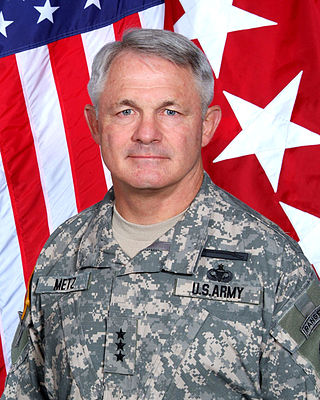
Thomas Fredric Metz is a retired lieutenant general in the United States Army. Metz retired from the Army in Jan 2010 after more than 40 years of active military service. His tour of duty prior to retirement was as the director, Joint Improvised Explosive Device Defeat Organization., leading the DOD organization tasked with finding and fielding ways to defeat the IED threat. Previously he was the deputy commanding general and chief of staff, U.S. Army Training and Doctrine Command. Previous to that assignment he was commanding general of the U.S. III Corps and Fort Hood. He assumed command of III Corps on 7 February 2003.
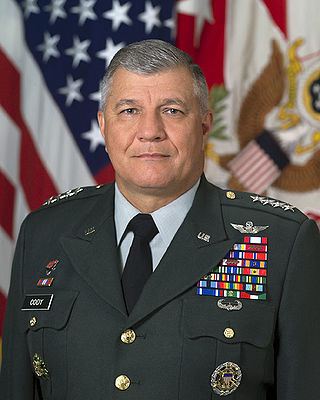
Richard Arthur "Dick" Cody is a retired United States Army general who served as the 31st Vice Chief of Staff of the United States Army from June 24, 2004 to July 31, 2008. He retired from the Army on August 1, 2008.

The 1st Engineer Battalion is a unit of the United States Army with a record of accomplishment in both peace and war; an organization that provides sustained engineer support across the full spectrum of military operations. The 1st Engineer Battalion is the oldest and most decorated engineer battalion in the US Army, tracing its lineage to the original Company of Sappers and Miners organized at West Point, New York in 1846.

James David Thurman is a retired United States Army general who served as the Commander of United Nations Command, R.O.K.-U.S. Combined Forces Command, and United States Forces Korea from July 14, 2011 until October 2, 2013. He previously served as the 18th Commanding General, United States Army Forces Command from June 3, 2010 to July 8, 2011 and as Deputy Chief of Staff, G-3/5/7. He was the former commanding general of United States V Corps in Heidelberg, Germany from January 19, 2007 to August 8, 2007.

John M. Brown III is a retired lieutenant general of the United States Army. He served as Commander of United States Army Pacific, headquartered at Fort Shafter, Hawaii, from August 25, 2004 to February 1, 2008. He enlisted in the Army as an infantryman in 1969 and became an officer upon completion of Infantry Officer Candidate School in 1971 where he was commissioned a second lieutenant of Infantry.

R. Steven Whitcomb is a retired United States Army lieutenant general. He was commissioned as a second lieutenant upon graduation from the University of Virginia in 1970. In his final assignment he served as Inspector General of the United States Army.
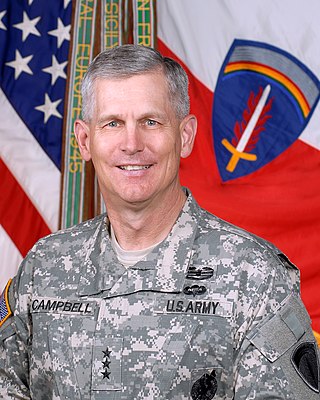
Lieutenant General Donald M. Campbell Jr. is a retired United States Army lieutenant general who served as the commanding general of United States Army Europe. He commanded the United States Army Europe from December 1, 2012 to November 6, 2014.

Lieutenant General Jack C. Stultz, Jr. is a retired United States Army general who served as the commanding general of the United States Army Reserve.
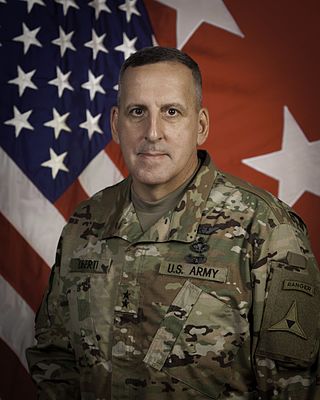
Major General John Uberti is a retired military officer who last served as the deputy commanding general for operations for the U.S. Army's III Armored Corps at Fort Hood, Texas.

James L. Terry is a retired lieutenant general of the United States Army. Terry has commanded at multiple levels across the Army. Terry's last assignment was as the commanding general of United States Army Central, retiring 17 November 2015. Terry served as the last commander of V Corps before its inactivation in 2013. While commanding V Corps, he concurrently served as Commander, International Security Assistance Force Joint Command (IJC), and as deputy commander of United States Forces Afghanistan. He was the Commanding General of the 10th Mountain Division from 2009 to 2011.

Lieutenant General Sean Barry MacFarland is a retired three-star general who served in the United States Army.
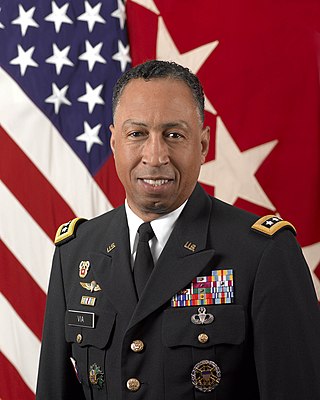
Dennis L. Via is a retired United States Army four-star general who last served as the 18th commanding general of the United States Army Materiel Command from August 7, 2012 to September 30, 2016. He is the first Signal Corps officer since General Henry H. Arnold to achieve four-star rank. He retired from the army on September 30, 2016 after over 36 years of service.

Paul Edward Funk II is a retired four-star general in the United States Army who last served as the commanding officer of the Army Training and Doctrine Command. He previously served as the 60th Commanding General of III Corps and Fort Hood, Texas, and as the Commanding General, Combined Joint Task Force – Operation Inherent Resolve. Funk was born at Fort Hood, Texas, graduated from Fort Knox High School, and was commissioned an Armor Officer through ROTC upon graduation from Montana State University in 1984. His first assignments saw him serve in a variety of Armor and Cavalry roles to include Tank Platoon Leader, Company Executive Officer, Squadron Commander of 1st Squadron, 7th Cavalry Regiment and Brigade Commander of 1st Brigade Combat Team, 1st Cavalry Division located at Fort Hood.
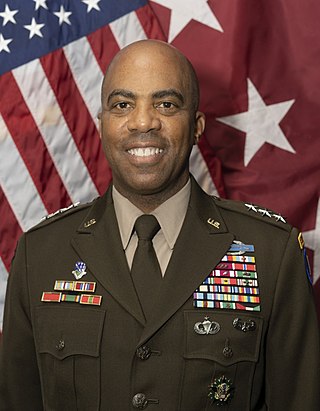
Ronald Patrick "Ron" Clark a United States Army lieutenant general who serves as the senior military assistant to the United States Secretary of Defense. He previously commanded the United States Army Central from 2021 to 2022. He also served as the Chief of Staff, United States Indo-Pacific Command. He previously served as the commander of the 25th Infantry Division, and, before that, as the Chief of Staff, United States Army Pacific.
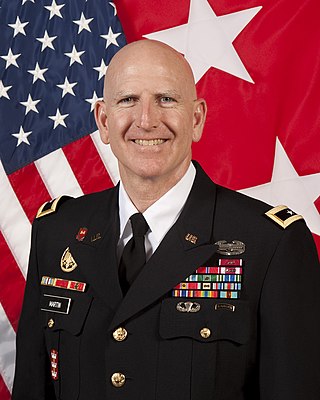
Gregg F. Martin is a United States Army two-star general who retired as the Special Assistant to the Chief of Engineers in 2014. From July 2012 to July 2014 he was the President of the National Defense University at Fort McNair Army Base in Washington, D.C. and from July 2010 to July 2012 he served as the Commandant of the U.S. Army War College in Carlisle, PA. He served as second in command for 3rd Army/US Army Central in the Central Command Area of Responsibility, including support operations in Iraq and Afghanistan, and across the CENTCOM region from January 2010 to April 2010 and he led a complex enterprise of four major schools that educated, trained and developed thousands of soldiers, marines, airmen, sailors and civilians for leadership roles in global operations as the Commanding General at the Maneuver Support Center of Excellence in Fort Leonard Wood, Missouri from October 2008 to January 2010. After retiring from the military, General Martin revealed that he is a survivor of bipolar disorder in an effort to reduce the stigma of that condition.
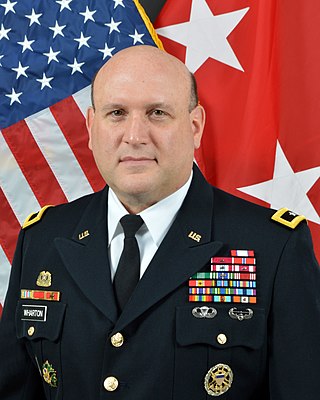
Major General John Francis Wharton is a retired United States Army officer and career logistics officer who last served as the commanding general of the U.S. Army Research, Development and Engineering Command at Aberdeen Proving Ground, Maryland. Before that, Wharton served as the commanding general of U.S. Army Sustainment Command and Rock Island Arsenal, and as the senior commander for U.S. Army Garrison, Rock Island, Illinois.




















